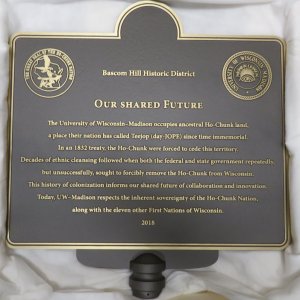
On June 18, leaders of the Ho-Chunk Nation, as well as UW alumni and campus leadership joined together to dedicate a new plaque on Bascom Hill recognizing the land as the ancestral home of the Ho-Chunk, acknowledging the circumstances that led to their forced removal, and honoring their history of resistance and resilience.
Below are Chancellor Blank’s edited remarks, as prepared for delivery.
I want to welcome all of the people from the Ho-Chunk Nation and UW who have worked together and who will continue to work together to recognize and honor the 13,000-year history of the Ho-Chunk people on this land, and acknowledge the forcible removal of the Ho-Chunk from this region…a removal that they resisted and from which they returned.
After 171 years, it is time for this campus to be more intentional in telling this story.
The heritage marker is one small step in that direction, and I want to read you the words that appear on it.
It is titled “Our Shared Future” and it shows the Great Seal of the Ho-Chunk Nation and the seal of the University of Wisconsin-Madison.
It reads as follows:
The University of Wisconsin-Madison occupies ancestral Ho-Chunk land, a place their nation has called Teejop since time immemorial.
In an 1832 treaty, the Ho-Chunk were forced to cede this territory.
Decades of ethnic cleansing followed when both the federal and state government repeatedly, but unsuccessfully, sought to forcibly remove the Ho-Chunk from Wisconsin.
This history of colonization informs our shared future of collaboration and innovation.
Today, UW-Madison respects the inherent sovereignty of the Ho-Chunk Nation, along with the eleven other First Nations of Wisconsin.
[Dated 2018]
No plaque or monument can ever adequately convey a complicated and difficult history. But they can start a conversation that begins to move us from ignorance to awareness. So today is the beginning of an intentional effort to teach our shared history. We already incorporate the Ho Chunk history and Wisconsin Native American history into some of what we do, and we will continue to expand that, including it in such areas as:
- Campus tours on the Native American history of this campus
- The “Our Wisconsin” program, which is an introductory workshop for our first-year students living in the university residence halls.
- In the new UW-Madison Public History Project.
- And in different ways in our curriculum
Campus leaders are continuing to explore other ways to educate and illuminate this history with our university community.
As you can see, we are doing major repairs to the steam tunnels under Bascom Hill, so we are not putting the marker here right now. We will ask units across campus to host the marker over the next year, to make it as visible as possible. It will then return to its permanent home here on Bascom Hill when the steam tunnel repair is complete.
Our soon-to-be-hired Director of Tribal Relations will help to coordinate careful placement of the plaque at key sites on campus, and will work with Native Nations of Wisconsin to identify other areas where we might collaborate.
I want to close as I began, by thanking each of you, and extending my deep gratitude to the Ho-Chunk people who have been willing to work with us on this plaque and on other collaborations.
The great Ho-Chunk artist and UW Professor Truman Lowe, who passed away two months ago, once talked about some of the things that influenced his art. He said:
“I continue to be fascinated by water and streams. Moving water, and the idea of movement … because there has to be continual movement and evaluation in life to solve all the things we’re concerned about.”
I hope we will continue to embrace the idea of continual movement – it may not always be in the direction we intend, but if we proceed together with a willingness to teach and learn, I believe we can arrive at a new and better place.
Pinagigi. Thank you.